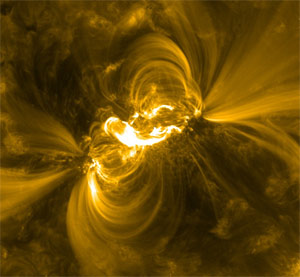 In the late afternoon yesterday (February 13, 2011) sunspot 1158 released a decent-sized solar flare, a magnetic eruption on the Sun. This was classified as an M6.6 flare, which is above average in explosive energy, but hardly up to the nastiness we experienced in late 2003 when the Sun was throwing an epic hissy fit.
In the late afternoon yesterday (February 13, 2011) sunspot 1158 released a decent-sized solar flare, a magnetic eruption on the Sun. This was classified as an M6.6 flare, which is above average in explosive energy, but hardly up to the nastiness we experienced in late 2003 when the Sun was throwing an epic hissy fit.
The image here is from the Solar Dynamics Observatory, and shows the sunspot in the extreme ultraviolet part of the spectrum. This is the first solar flare sending energy toward the Earth since the Sun started its magnetic cycle up again last year. That may sound scary, but we’ll be OK. First of all, it’s not all that big a flare. Second, the effect comes in two ways: through electromagnetic energy (light), and subatomic particles. The first is already over, and the second will be buffered by the Earth’s magnetic field.
Here’s how this works: the Sun’s magnetic field is extremely complicated, with lots of magnetic field lines embedded in packets of ionized gas (called plasma) that rise and fall beneath the surface. These field lines can pierce the Sun’s surface, loop up, and then come back down to create a complete circuit (as you can see in the SDO pic above; the plasma follows the field lines and glows). All these field lines can get tangled up, like a sack full of stretched springs, and there’s a huge amount of energy that can be stored in these magnetic fields. If one of them suddenly connects with another it can release its energy, snapping other lines… and you get an enormous cascading release of energy. Boom! Solar flare.
Sometimes vast energies are released this way; some huge flares have blasted out 10% the energy of the entire Sun! This latest one was very mild compared to that though.
When the explosion occurs, the blast moves upward into space, sending out a wave of subatomic particles moving at speeds of upwards of millions of kilometers per hour. There can also be a flash of extremely high-energy gamma rays. Those are photons of light, like visible light but vastly more energetic. They move out at the speed of light (of course, since they are light!). So when an observatory like SDO spots a flare, the gamma rays are already here. Happily, those get absorbed by our atmosphere, and really don’t pose a threat to us on the ground.
However, in space things are different. Those gamma rays can hit satellites and send a flood of fast electrons through the circuitry, frying the electronics. Also, the wave of subatomic particles follows hours or days later, hits our Earth’s magnetic field, and can also cause havoc in satellites. If the wave is big enough it can even cause blackouts here on Earth!
Of course, that’s why we have SDO and other satellites observing the Sun. We can see this coming and take measures to minimize the effects. Shut down vulnerable satellites, redirect power on Earth to lower the strain on the grid, and so on. This particular flare doesn’t seem to be causing much distress according to the Space Weather Prediction Center (here in Boulder), but there might be some nice aurorae if you live at an extreme north or south latitude. Keep your eyes open for that tonight!
I’ll also note that, via reddit, I learned of a website that is making all sort of goofy weather predictions because of this flare. I can’t state categorically that flares don’t affect our weather, but if they do it is in such a minuscule way that it’s very difficult to correlate the two. That site was talking about increased rainfall in Europe from the flare, which is simply nonsense. And I also don’t think you need to worry about superstorms, either.
As the Sun’s magnetic cycle ramps up over the next couple of years, solar astronomers will be keeping track of what’s what. We have several satellites watching our star with unblinking eyes, and if there’s any cause for actual worry, you’ll hear about it from reliable source like SpaceWeather and Universe Today. And I might have a thing or two to say as well.
Image credit: NASA/SDO
Related posts:
- A huge looping prominence on the Sun /a>
- The Sun blasts out a flare and a huge filament
- The Sun rises again
- One solar piece of flare